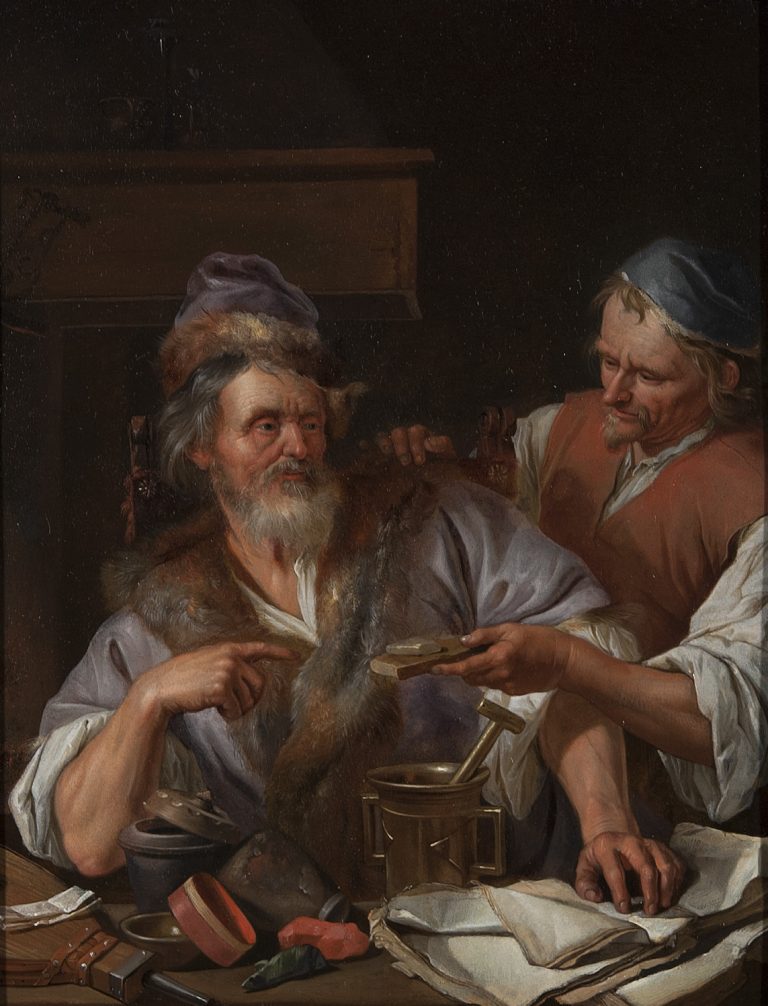Originating in ancient philosophy, alchemy in early modern Europe was considered a pseudoscience of transmutation, in which a base metal (for example, lead) was to be transformed into a noble metal, such as gold or silver. Reflecting contemporary perception of the mystic as well as the scientific nature of this tradition, two rather contradictory ways of portraying the alchemist exist in the visual tradition of the northern and southern Netherlands. One depicts the alchemist as a charlatan in search of the magical ability to create gold, and the other depicts him as a scientific scholar, laying the foundation for the early development of modern chemistry.1
The first approach, employed throughout the sixteenth and seventeenth centuries, characterized the alchemist as the object of satire and a symbol of human folly. His futile experiments in changing base metals into gold were represented as sinful quests for personal gain. In this view of alchemy, alchemists inevitably ended up wasting precious time and money, thereby sacrificing the welfare of their families.(fig 1) Pieter Brueghel the Elder’s (ca. 1525–69) drawing Alchemist, ca. 1658, depicting the alchemist as a profligate, served as an important source of inspiration for later generations of artists, including David III Rijckaert (1612–61), Jan Steen (1626–79), and Adriaen van Ostade (1610–85).2 In Jan Steen’s Village Alchemist, for example, the artist depicts an elderly alchemist as being oblivious to the poverty of his surroundings, especially that of his own family. His young wife holds their infant in her arms and casts a discouraged glance up at an empty moneybag hanging from the ceiling (fig 2).3
David Teniers the Younger (1610–90) introduced the second common portrayal of the alchemist in the 1640s, and his example was followed by, among others, Thomas Wijck (1616–77), Frans van Mieris the Elder (1635–81), and Cornelis Bega (1631–64).4 Despite the often skeptical view of the profession, alchemy was, in fact, a precursor to modern chemistry and pharmacology. In the course of their experiments, alchemists developed chemical processes like distillation and dissolution, and increased the knowledge of the physical world, which was of great practical use in, for instance, the chemistry of medicine, which distilled herbs to make elixirs.5 In Teniers’s Alchemist in the Mauritshuis, the alchemist is portrayed as a wise and humble scientist diligently absorbed in his research and surrounded by a variety of instruments, such as distillation equipment (fig 3).6 Teniers’s alchemists are often accompanied by one or two assistants who take charge of the execution of the experiment. His laboratories do not include motifs that suggest the self-deception and resultant misery often associated with alchemy, such as empty moneybags or weeping families.
Jacob Toorenvliet’s interest in the alchemist as a scientist developed over many years. In the late 1660s, undoubtedly when he was living in Vienna, Toorenvliet first painted an image of a scholarly alchemist devoted to his experiment; he then repeated the subject in 1679 after he had returned briefly to his native Leiden (fig 4).7 In the latter picture the alchemist is depicted as an intellectual deeply engrossed in his experiment, evinced by the books and notes on the table.8 The depiction of an alchemist as a master instructing his assistant is first seen in Toorenvliet’s Alchemist and His Two Assistants, which he executed in the late 1660s.9 The Leiden Collection painting is dated 1684 and was executed during the artist’s Amsterdam years. Nevertheless, the painting’s composition and style, with two half-length figures placed close to each other and against a shaded background, are comparable to works that the artist made during his Viennese period.
The inspiration for Toorenvliet’s positive depictions of alchemists was undoubtedly David Teniers the Younger, whose paintings were highly regarded by Archduke Leopold Wilhelm and his successors in Vienna. Teniers’s pictures of alchemists would have been familiar to Toorenvliet while he was in that city. As in Teniers’s pictures, there is no allusion to misery or deception in Toorenvliet’s paintings of alchemists.10 In the Leiden Collection painting, Toorenvliet’s alchemist has one hand on the crumpled pages of a manuscript resting on a work table filled with vessels and a wooden bellows. He interacts easily with his assistant, who has come to show him a piece of metal he has been heating in the fire partially visible behind them. It is a moment of intellectual exchange, where the two men respond to the results of the experiment they are conducting. With a surety of touch and command of his subject, Toorenvliet creates an engaging scenario, where the men’s active gesture and counter-gesture reflect the excitement of the moment and the expectation of discovery.
